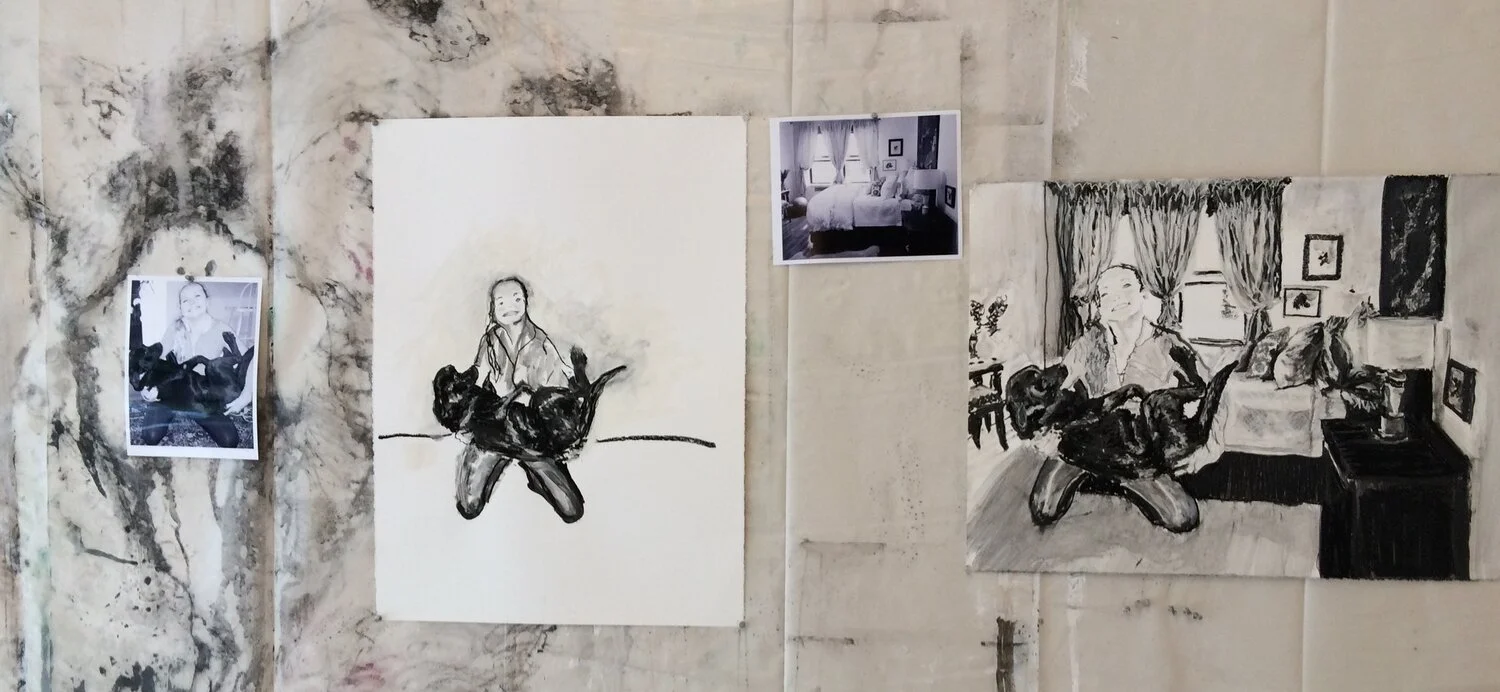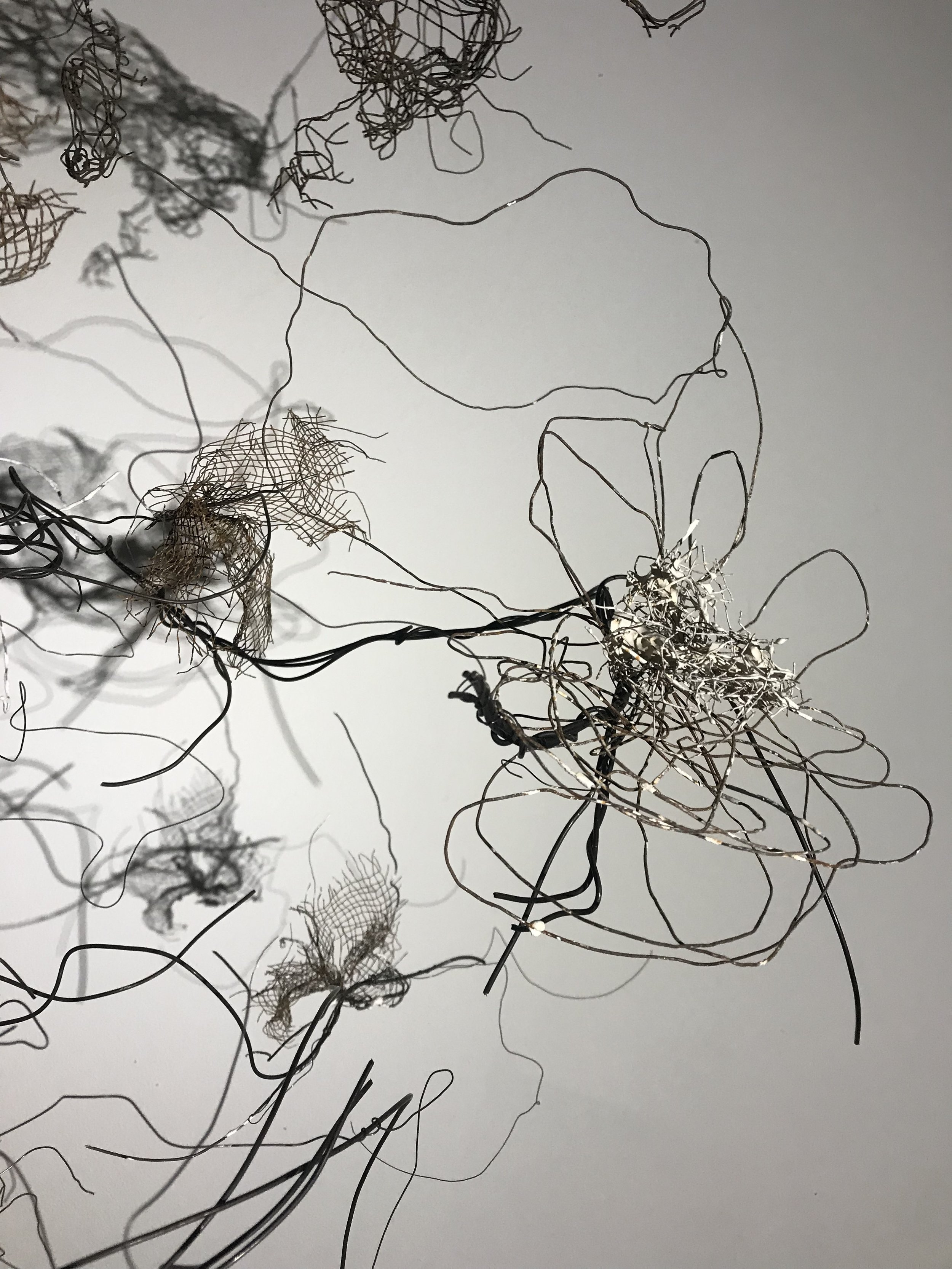Editing bee parts and adding botanical elements.
Glyphosate #11 (working title) kinetic sculpture - adding more bees
Glyphosate #10 (working title) kinetic sculpture - another floral add
Glyphosate #9 (working title) kinetic sculpture - a look at the shadows
Glyphosate #8 (working title) kinetic sculpture - a better look at two bees
I edited them more after more pieces are added.
I need to add some hydro stone pieces to the second wing.
Here I am considering if he needs a second wing or not.
Some news regarding seed killers-
https://www.courthousenews.com/jury-awards-couple-1-billion-in-roundup-cancer-case/
Glyphosate #7 (working title) kinetic sculpture - adding some details
In order to help the large abstract shapes read as botanical or floral shapes I have added some smaller botanical shapes and vines. I think they help.
hopefully this flower is abstracted enough but not too much.
Here is another
Glyphosate #6 (working title) kinetic sculpture - hydro stone
Regarding the title today I am loving “impact” as a title, I will discuss more on that in another post.
On this day I made abstract botanical inspired shapes out of a variety of materials. Then I whipped up some hydro stone and put a coat on the largest shape. The next day I started arranging the pieces into a kinetic composition.
botanical inspired small pieces.
the large piece covered in hydro stone
Above I am starting to connect the pieces.
Glyphosate #5 (working title) kinetic sculpture - flower and 2 bees
I have not added the legs and wings to the 2nd bee. All the bees do not need legs and wings????????
When I add the hydro stone it will be easier to discriminate between the bees and the flowers.
Below are two different compositions using the flower and the two bees.
Glyphosate #4 (working title) kinetic sculpture - a flower
checking out shapes that hopefully read as floral.
Regenerative agriculture and buying organic
The importance of where your food comes from. This article does a good job of explaining how your grocery shopping can trickle down and impact climate change.
https://www.cornucopia.org/2019/04/organics-climate-change/
These photos are from the Buffalo Speedway and Westheimer Saturday Farmers market.
Glyphosate (working title) kinetic sculpture #3 - another bee
I start with the eyes. I always start with the eyes from dogs, to my cousin Drew the concert master to bumble bees.
Regarding figurative abstract pieces- If you can’t recognize the eyes then it is hard to read an abstract piece as a living creature. Reading the eyes is important.
Checking the shadow with the fuzz and the clarity of the eyes.
Adding the armature for the abdomen and tail and checking the shadow and the eyes.
A a very fine mesh might be nice for the exoskeleton. Where are the eyes?
another view
Adding bee #1 just to see how they relate
I am hoping to be able to add some legs, wings
and dead flowers soon. I am a little worried about the eyes.
Glyphosate (working title) mobile #1 - new body of work.
This summer I will be focused on building a body of work that addresses the impact that pesticides have on the bumble bees and honey bees.
“Why conserve
rusty patched bumble bees?
As pollinators, rusty patched bumble bees contribute to our food security and the healthy functioning of our ecosystems. Bumble bees are keystone species in most ecosystems, necessary not only for native wildflower reproduction, but also for creating seeds and fruits that feed wildlife as diverse as songbirds and grizzly bears.
Bumble bees are among the most important pollinators of crops such as blueberries, cranberries, and clover and almost the only insect pollinators of tomatoes. Bumble bees are more effective pollinators than honey bees for some crops because of their ability to “buzz pollinate.” The economic value of pollination services provided by native insects (mostly bees) is estimated at $3 billion per year in the United States.”
https://www.fws.gov/midwest/endangered/insects/rpbb/factsheetrpbb.html
Below is a still image of a 4D/mobile piece I started last week.
A dead bee without legs and very big broken wings.
Here is a photo of the shadow. The sculpture is photobombing on the right.
Glyphosate (working title) mobile #2 + legs
shadow and sculpture
Glyphosate lenticular- trying to get it right
I printed a lenticular from my three mono-prints of a dead bee. I decided to loop the images. That was a mistake when it comes to creating imagery that speaks to extinction. There is no loop and no second chance. With that in mind, I am trying for proof #2 with out a loop of image number 2.
I think this will work 🐝
Glyphosate mobile - New work -
I might call this collapse and disorder.
I started a new shadow/mobile to be part of my Glyphosate series. Last week I started the wings.
Above I am started the wings with some leftover pieces from “Bringing Home The Bacon” held together with new wire.
a wing and its shadow
Before I left for the day I threw together a body to slap on the wings and see what the shadows look like.
I am considering the title “collapse and disorder” for this piece.
I will probably add some hexagon shapes to the sculpture. Which made me wonder why are honeycombs hexagon in shape. Guess what I found?
Roots #5 after the pour- patina
breaking out the handle
I coved the piece in liver of sulfur and now it is time to add the green moss.
adding the moss green patina
one of the three new pieces added to strengthen the support and spread the load weight.
I thought I was ready to plan the faux bois handle, but while thinking through the process, it became evident that the root pieces supporting the structure are too small. I am concerned that under the weight of the concrete, they will bend. My solution is to add new pieces that are thicker to spread out the load.
I thought that it would be simple to add the patina to the new support pieces - wrong! It looks like I charred the new pieces. When things go wrong, it can be so frustrating.
Sandblasted and ready for Patina application #2.
The patina recipe I am using.
A tip from David Delgado at Legacy fine art Foundry - After the birch wood Casey have some ferric ready and add a wash of ferric before the cupric nitrate mixture. This will help keep it green and not cupric blue.
birchwood Casey ✅
cupric nitrate
Just in time for earth day
Glyphosate - bumblebees on the endangered sources list
With Earth Day in mind I would like to remind gardeners to not use Roundup. The chemical Glyphosate impacts the bee’s intestinal flora causing it’s immune system to be weakened. With bees on the decline we can not compromise their immune systems.
Glyphosate 44” X 30” watercolor monotype
51.88” Art of resilience
Buffalo soldiers in El Paso
Who knew? Art exposes one to so many unknown things.
Hurricane Harvey - Heroes LIVEstock
In my original body of work “Harvey Heroes” the installation. I paid specific attention to selecting images for inspiration from all ethnic backgrounds. During the Hurricane Harvey flood rescue, racial, political gender and religious tensions were washed away. They were not part of the conversation, we were one people. That was the silver lining of Hurricane Harvey, that was what raised our Texas spirit above the flood line. Seeing people of all backgrounds helping each other made me proud to be from Houston. In the installation piece the process I use to get the abstract fluidity marks, dilutes the diversity of skin tones. I feel this process addresses skin tones as Harvey did. The work is very abstract and does not show the details that might define a particular ethnic background, again the spirit of Harvey.
The exhibition opening was pushed back 30 days, with the extra time I decided to add a few LIVEstock pieces. There were not a lot of images from Harvey of livestock rescues on social media so I created a few of my own.
I regretted I had not made a buffalo calf rescue piece. Saving the buffalo is my thing. Not long after making the decision to make a buffalo rescue piece I saw an image posted on Instagram of a black cowboy wearing a white hat. Immediately I thought how cool it would be to have a black cowboy rescue a buffalo calf. A white hat would separate a darker skin tone from my murky floodwater background, plus my new 44” X 30” paper and plate would help show more skin tone characteristics than the 22” X 30” pieces that compose the installation.. When I told Curtis what I was planning he, immediately, reminded me of the Buffalo Soldiers. He suggested I visit the Buffalo Museum to make sure it would be acceptable during today’s sensitive times to reference Buffalo Soldiers. The people at the museum were very busy so I did not bother them. I did consulted with one of my friends, artist Romeo Robinson; he liked the idea.
This piece has multiple layers of meaning. It brings attention to the importance of tending to animals in rural environments when floods occur. It brings attention to saving the buffalo from extinction and it addresses regenerative agriculture. Most importantly, it is an opportunity to celebrate and acknowledge the brave men who served our country in the military; the Buffalo Soldiers. They were given the name Buffalo Soldiers by the Native Americans, because the Buffalo Soldiers were as tough, fierce and brown as the American buffalo. They were admirable Americans. They deserve accommodations. While at the buffalo Soldier Museum I learned that the US government has never given the Buffalo Soldiers any accommodations for their service. They fought in the Civil War and WWI, This piece celebrates heroes on a multiple of levels.
The piece below, the African-American cowboy is rescuing a buffalo calf. The white cowboy hat and white shirt separate the black skin on his face from the chaotic weather in the background.
I made one monotype and two ghost monotypes. See below.
I hope you like them.














































